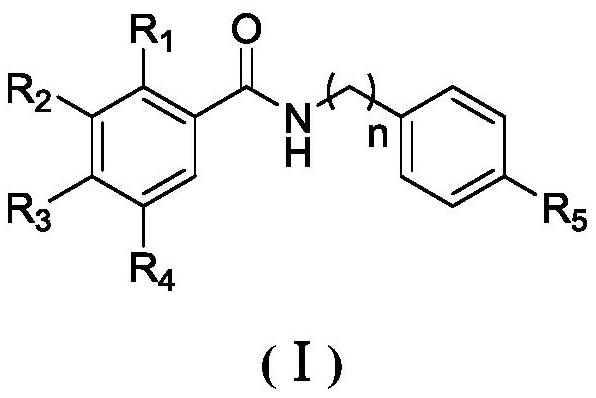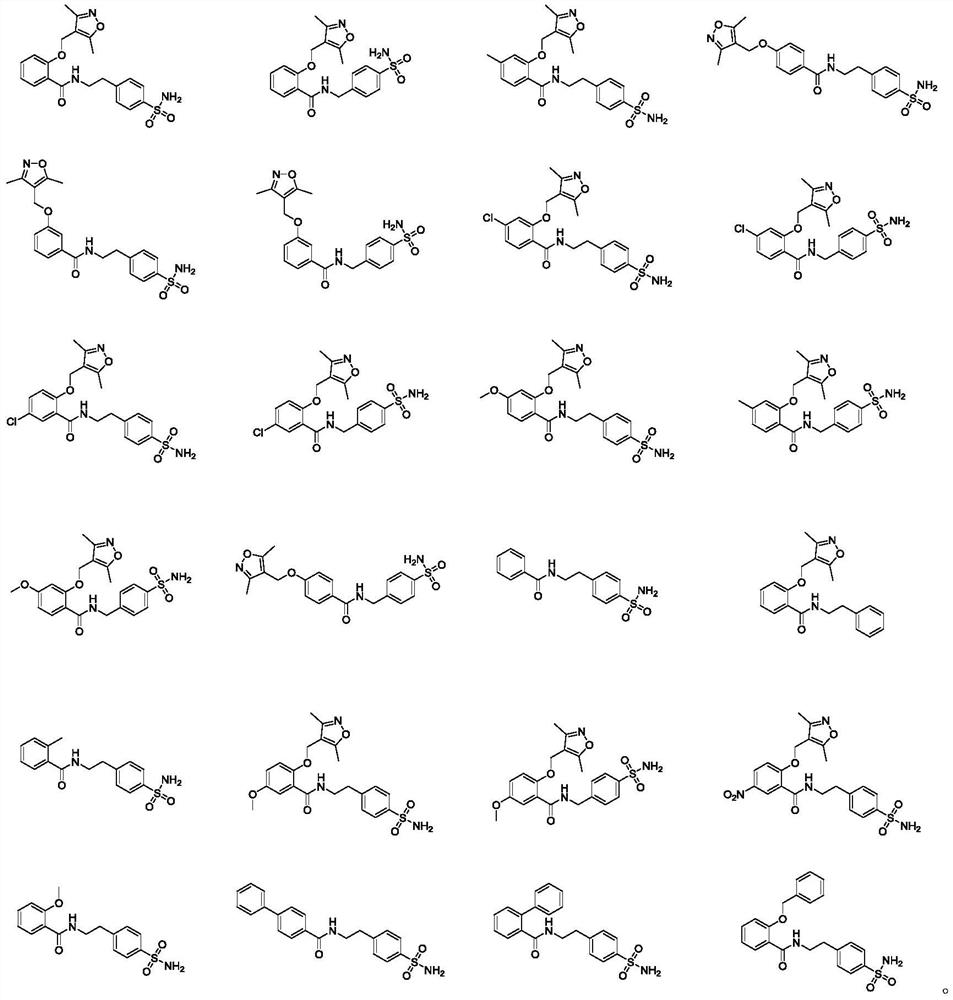AKR1C3 selective inhibitor as well as preparation method and application thereof
A selective and inhibitory technology, applied in the preparation of sulfonic acid amides, organic chemistry, anti-tumor drugs, etc., to achieve good application prospects, rich structural types, good inhibitory activity and selectivity.
- Summary
- Abstract
- Description
- Claims
- Application Information
AI Technical Summary
Problems solved by technology
Method used
Image
Examples
Embodiment 1
[0039] (1) Synthesis of methyl 2-((3,5-dimethylisoxazol-4-yl)methoxy)benzoate (intermediate 2a)
[0040] Methyl 2-hydroxybenzoate 1a (130 μL, 1.21 mmol) was dissolved in acetonitrile (6.57ml), and 4-(chloromethyl)-3,5-dimethylisoxazole (163 μL , 1.21mmol), potassium carbonate solid (268mg, 1.97mmol), potassium iodide solid (114mg, 0.66mmol), heated and stirred overnight at 80°C. After the reaction was complete, 20 mL of water was added, extracted three times with ethyl acetate, and the organic layers were combined and dried over anhydrous sodium sulfate. After evaporating the solvent under reduced pressure, silica gel column chromatography (eluent: PE / EA=15 / 1, v / v) was performed. The intermediate methyl 2-((3,5-dimethylisoxazol-4-yl)methoxy)benzoate (white solid, 100 mg, yield 30%) was obtained. 1 H NMR (300MHz, DMSO-d 6 )δ7.67(dd, J=7.7,1.8Hz,1H),7.59(ddd,J=9.1,7.4,1.8Hz,1H),7.31(d,J=8.1Hz,1H),7.08(td,J =7.6,0.8Hz,1H),5.02(s,2H),3.77(s,3H),2.43(s,3H),2.27(s,3H).
[0041]...
Embodiment 2
[0047] Synthesis of 2-((3,5-dimethylisoxazol-4-yl)methoxy)-N-(4-sulfamoylbenzyl)benzamide
[0048] To a DMF solution (12 mL) of intermediate 3a (200 mg, 0.8 mmol) was added 2-(7-azabenzotriazole)-N,N,N',N'-tetramethylureahexa Fluorophosphate (460mg, 1.2mmol) and N,N-diisopropylethylamine (400μL, 2.4mmol) were activated for half an hour and then added 4-(aminomethyl)benzenesulfonamide hydrochloride (270mg, 1.2mmol) . After the reaction was complete, 60 mL of water was added to the reaction liquid, and extracted three times with ethyl acetate. The combined organic layers were washed with brine and dried over anhydrous sodium sulfate. After the solvent was distilled off under pressure, the solid obtained was recrystallized to obtain 2-((3,5-dimethylisoxazol-4-yl)methoxy)-N-(4-sulfamoylbenzyl)benzamide (Compound 2, off-white solid, 170 mg, yield 53%), detected by TLC as one spot, with dark spots under 254nm UV lamp, no fluorescence under 365nm. 1 H NMR (300MHz, DMSO-d6) δ8.67(...
Embodiment 3
[0050] Synthesis of 2-((3,5-dimethylisoxazol-4-yl)methoxy)-4-methyl-N-(4-sulfamoylphenethyl)benzamide
[0051] Referring to the synthetic method of Example 1, the 2-hydroxybenzoate methyl ester in Example 1 is replaced by 2-hydroxyl-4-methylbenzoate methyl ester to obtain 2-((3,5-dimethylisoxan Azol-4-yl)methoxy)-4-methyl-N-(4-sulfamoylphenethyl)benzamide (compound 3), TLC detected as one point, dark spot under UV lamp 254nm, 365nm No fluorescence. 1 H NMR (300MHz, DMSO-d6) δ8.03(t, J=5.5Hz, 1H), 7.77–7.70(m, 2H), 7.55(d, J=7.8Hz, 1H), 7.38–7.28(m, 4H), 7.11–7.05(m, 1H), 6.87(d, J=7.8Hz, 1H), 5.03(s, 2H), 3.48(q, J=6.8Hz, 2H), 2.79(t, J=7.1 Hz,2H),2.41(s,3H),2.34(s,3H),2.19(s,3H).HPLC(80%methanol in water with 0.1%HCOOH):t R =14.091min, 96.153%.
PUM
 Login to View More
Login to View More Abstract
Description
Claims
Application Information
 Login to View More
Login to View More - Generate Ideas
- Intellectual Property
- Life Sciences
- Materials
- Tech Scout
- Unparalleled Data Quality
- Higher Quality Content
- 60% Fewer Hallucinations
Browse by: Latest US Patents, China's latest patents, Technical Efficacy Thesaurus, Application Domain, Technology Topic, Popular Technical Reports.
© 2025 PatSnap. All rights reserved.Legal|Privacy policy|Modern Slavery Act Transparency Statement|Sitemap|About US| Contact US: help@patsnap.com



